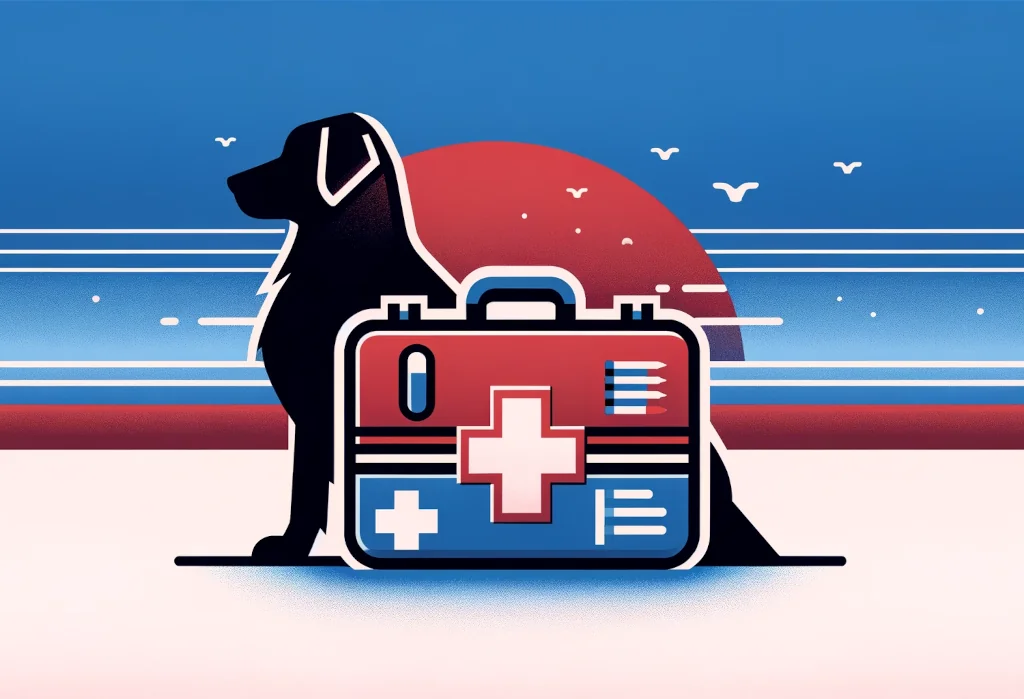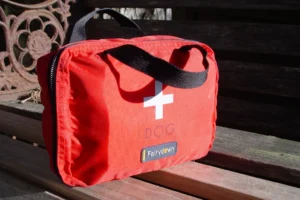Imagine you’re getting ready for a weekend movie marathon when Mother Nature decides to roll the dice. Suddenly, your main concern shifts from what snacks you have to whether you and your fluffy companion are storm-ready.
Let’s be real, ensuring our beloved dogs are safe during an emergency feels like trying to solve a Rubik’s cube blindfolded. But hey, collapse that worry tent! This blog post will guide you step-by-step to ensure you and your dog are prepped and ready for whatever curveballs life throws your way.

Quick Takeaways:
- Pack an emergency kit for your dog including a three-day supply of food and water, medications, medical records, a first-aid kit, comfort items, hygiene supplies, and updated identification.
- Employ strategies to keep your dog calm during emergencies, such as staying calm yourself, creating a safe space, and using familiar items or calming aids.
- Ensure your dog’s microchip and ID are up-to-date and train them to respond to critical commands, to be carried or transported calmly, and to remain calm amidst unusual noises and situations.
What Should Be in Your Dog’s Emergency Kit?
When disaster strikes, having an emergency kit for your furry friend is as crucial as having one for the rest of your family. Here’s the lowdown on what to pack to ensure your dog has everything they need:
-
Food and Water: A three-day supply of food and water is advisable, packed in airtight containers to keep them fresh. Opt for collapsible bowls for their compact and lightweight design, making them easy to carry.
-
Medications and Medical Records: If your dog is on any medications, pack at least a week’s supply. Include a copy of their medical records in a waterproof container—these are invaluable during an emergency vet visit.
-
First-Aid Kit: You can purchase a pet-specific first-aid kit or create your own. Key items include gauze, tape, scissors, antiseptic wipes, a pet thermometer, and styptic powder to stop bleeding.
-
Comfort Items: Don’t forget a toy or blanket to provide a sense of familiarity and comfort in unfamiliar surroundings.
-
Poop Bags and Hygiene Supplies: Maintaining cleanliness is crucial, even in an emergency. Pack enough poop bags, and consider puppy pads for indoor emergencies.
-
Identification: Ensure your dog’s collar tags are up-to-date and consider including a photo of you and your dog together in case you get separated.
Unique Tip: Include a rescue alert sticker on your home or apartment door/window to let rescuers know there are pets inside. You can get these free from many animal charities and organizations.
How Can You Keep Your Dog Calm During an Emergency?
Emergencies can ruffle the feathers of even the most laid-back dogs. Here are some tips to keep your canine companion calm under pressure:
-
Stay Calm Yourself: Dogs are incredibly adept at picking up on our emotions. By staying calm, you can help your dog feel more secure.
-
Create a Safe Space: If possible, set up a quiet, enclosed area that’s away from the main hustle and bustle. This can be a small room or even a crate if your dog is crate-trained.
-
Familiar Items: A favorite toy, blanket, or even a piece of your clothing can help soothe your dog with familiar smells.
-
Calming Treats and Aids: Consider natural calming treats or a pheromone diffuser. These can be effective tools in reducing anxiety in dogs.
-
Soft Music or White Noise: Playing soft, classical music or white noise can help drown out frightening sounds like thunder or sirens.
Is Your Dog’s Microchip and ID Updated?
One of the most overlooked aspects of pet ownership is keeping your dog’s microchip and ID tags current. Here’s why it’s a must-do:
Microchips give your pet the best chance of coming back to you if they get lost. However, a microchip is only as good as the information linked to it. Make it a habit to check and update your contact information annually or after any major life changes.
ID tags are your dog’s fastest ticket home. They’re the first thing a person who finds your dog will check. Make sure the tag has your current phone number and consider adding your email address as an extra point of contact.
Remember, the goal isn’t just to prepare for when disasters strike, but to ensure a swift and stress-free reunion with your furry friend should you get separated in the chaos that often accompanies emergencies. Keep these tips in hand, and you’ll be well on your way to safeguarding your four-legged family members with the diligence they deserve.
What Should You Know About Evacuating With Your Dog?
Evacuating with your dog doesn’t have to be a chaotic scramble. With a dash of preparation and a sprinkle of knowledge, you can ensure that both you and your furry friend make it to safety with less stress. Here’s what you need to keep in mind:
Pet-Friendly Shelters and Accommodations
Not all shelters accept pets, so it’s crucial to know your options ahead of time. Websites like PetFriendlyTravel provide a comprehensive list of pet-friendly shelters and hotels, which can be a lifesaver. Remember, the most immediate shelter isn’t always the best choice if they can’t accommodate your pet.
Keeping Pet Records Handy
Imagine this: you’re at a shelter or hotel that allows pets, but they require proof of vaccinations. Having your pet’s records easily accessible can prevent any delays or issues. A digital copy on your phone or in your email, along with a physical copy in a waterproof bag, is your best bet.
Transportation Logistics
If you’re evacuating by car, ensure your dog is comfortable with car rides. Consider a secure, comfortable crate or a safety harness. In case you have to evacuate on foot or by public transport, training your dog to be calm in a carrier is essential. And here’s a tip that might not be on everyone’s radar – if you’re in an area that frequently faces evacuation orders, consider a foldable wagon or a pet stroller. They can be a game-changer for mobility and comfort, especially for larger dogs or in scenarios where you have to move quickly but might face obstacles or long distances.
A Well-Thought-Out Plan Eases Stress
Planning can significantly reduce evacuation stress. Identifying routes, having a “go-bag” for your pet, and knowing your destination in advance can make all the difference. Your go-bag should include essentials like food, water, a favorite toy, and any medications.
Training Your Dog for Emergencies: Is It Possible?
Absolutely, and it’s not just possible; it’s highly recommended. Training your dog for emergencies can significantly enhance both of your abilities to handle unexpected situations calmly. Here’s how:
Critical Commands
Training your dog to respond to commands like “stay,” “come,” and “leave it” could be crucial in an emergency. For instance, if you need to keep your dog from running into harm’s way, a reliable “stay” can save their life. Start training these commands in a quiet environment and gradually introduce distractions to ensure your dog can respond in any situation.
Accepting Being Carried or Transported
For smaller dogs, being carried can be a part of daily life, but in an emergency, even larger dogs might need to be lifted. Teaching your dog to remain calm while being held or in a carrier can prevent added stress during evacuations. Use positive reinforcement to associate being held or being in a carrier with pleasant experiences.
Unique Training Tip
Here’s something that might not be widely discussed: Desensitize your dog to unusual noises and situations. In an emergency, the chaos isn’t just visual but auditory. Sounds of alarms, sirens, or even large crowds can unsettle your dog. Safely exposing them to these types of sounds at a low volume, gradually increasing over time, can help them remain calm in tumultuous situations.
Training isn’t just about commands; it’s about building a trusting relationship with your dog. In emergencies, dogs look to their owners for cues on how to react. If you’re calm and prepared, they’re more likely to be as well. Remember, patience and consistency are key in emergency preparedness training. It’s not an overnight success but an ongoing process that enhances the bond between you and your dog, ensuring you’re both ready for whatever comes your way.
Alex, a passionate animal lover, has experience in training and understanding animal behavior. As a proud pet parent to two dogs and three cats, he founded AnimalReport.net to share insights from animal experts and expand his knowledge of the animal kingdom.




